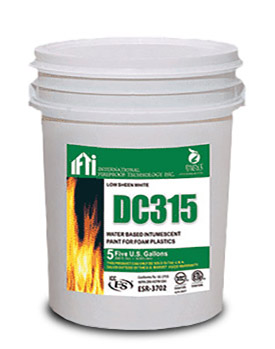WHY DO FIRE CODES REQUIRE THERMAL OR IGNITION BARRIERS?
SPF (spray polyurethane foam), like most other organic materials, is combustible. Although SPFs are formulated with flame retardants to meet the requirements of various construction codes and minimum performance standards there is still a need to provide further protection from fire. All foams must undergo some common fire tests such as ASTM E84, UL 723 and others, to determine how fast and how far a flame will travel across the surface, along with how much smoke is produced when the foam is exposed to a fire. However, the flame spread and smoke developed indexes from these tests are used solely to measure and describe properties of products in response to heat and flame under controlled laboratory conditions. The numerical indexes are not intended to reflect hazards presented by SPFs or any other material under actual fire conditions when left exposed. When exposed to fire sources, such as residential fires, trash fires, welding arcs, cutting torches or red-hot metal, unprotected SPF can ignite and may result in a flash fire. Although burning SPF will form a surface layer of less flammable char, which can increase the fire resistance, the initial burning can produce combustible gases and black smoke. These combustible gases can accumulate and ignite resulting in flashover, a dangerous fire situation. Under these conditions, additional foam and other combustibles can become involved in the fire, creating additional combustible gases and feeding the fire. It is this initial flashover potential along with high levels of smoke production that model building codes require SPF to be covered by thermal barriers or ignition barriers (depending on the use of the space), or to have the SPF assemblies meet large-scale fire tests such as NFPA 286 designed to ensure sufficient time for occupants to escape a fire prior to a flashover situation. This egress period is critical to meet life safety goals for building occupants. The Spray Polyurethane Foam Alliance publishes great guides and documents to support the SPF industry, be sure to check out their SPFA-126 "Thermal and Ignition Barriers for the SPF Industry"
 Need to order DC315 FR paint for SPF?
Need to order DC315 FR paint for SPF?
Published by ICC-ES,(International Code Council – Evaluation Services) The following Acceptance Criteria are utilized to prepare evaluation reports for SPF systems and assemblies: -
AC377 Acceptance Criteria for Spray Applied Foam Plastic Insulation, defines the testing requirements to demonstrate the spray foam meets the intent of the Code.
AC456 Acceptance Criteria for Fire Protective Coatings Applied to Spray Applied Foam Plastic Insulation without a Code-Prescribed Thermal Barrier, defines the testing requirements to demonstrate the coating meets the intent of the Code.
What are Evaluation Reports? Using Acceptance Criteria, Evaluation Reports assist local building officials to determine if, when and how building materials, products, components and methods comply with the language and intent of building codes. Organizations publishing these reports have engineers on staff who are familiar with building codes and construction materials and components. Local building code officials ultimately determine code compliance and may accept or reject all or parts of these reports.
Building Code Fire Performance Requirements for SPF: The International Building Code (IBC) mandates that SPF be separated from the interior of the building by a 15-minute thermal barrier, or other approved covering. DC315 Carries ICC-ESR 3702 and IAMPO ER-0499 Evaluation Reports confirming that DC315 meets IBC and IRC Code Requirements as either a thermal or ignition barrier, and lists all foams that have been tested as an assembly.
Recent Posts
-
Halloween Decor Safety: Protecting Costumes, Props & Haunted Houses with Fire Retardants
Halloween is one of the most creative holidays of the year. From glowing jack-o’-lanterns to elabora …Nov 5th 2025 -
Cost-Benefits of Investing in Fire Retardant Coatings
In today’s construction and safety-conscious environment, protecting buildings, assets, and people h …Nov 5th 2025 -
Fire Resistant vs Fire Retardant vs Intumescent: What's The Difference
When it comes to fire safety, the terms fire-resistant, fire-retardant, and intumescent are often us …Nov 5th 2025



